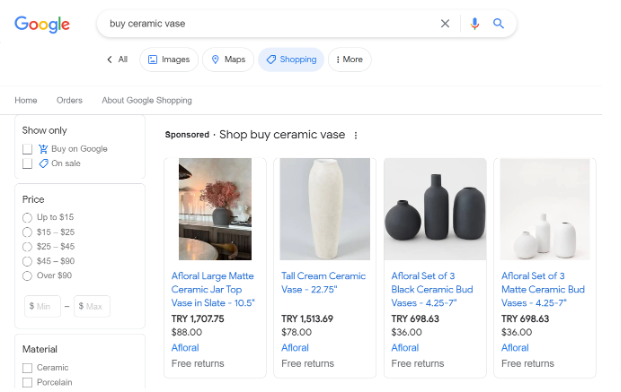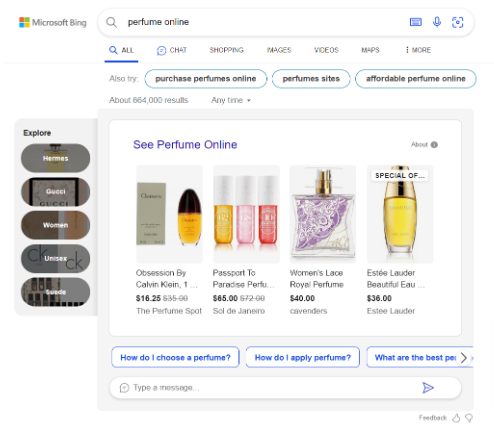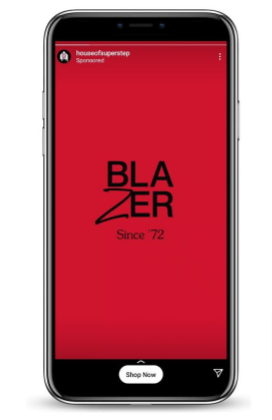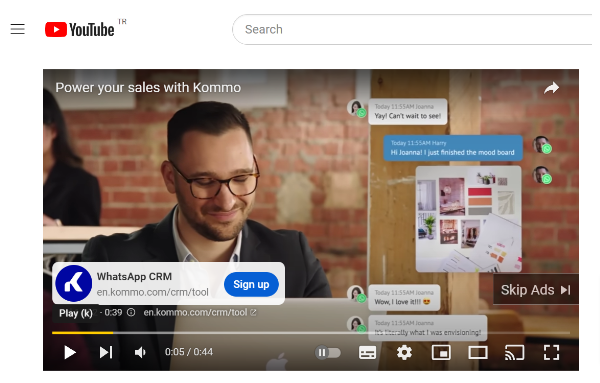With the surge in online shopping, standing out in the crowded eCommerce space is more challenging than ever. eCommerce advertising platforms offer the solution, equipping businesses with the tools to target and attract their ideal customers.
At their core, these platforms are systems that allow businesses to create, manage, and optimize advertisements specifically tailored for online retail environments. They can be standalone systems or integrated into larger ecommerce software ecosystems.
This guide will introduce you to key advertising platforms, demonstrate how they can enhance your online visibility.
Google Ads
Statista reported that in July 2023, Google dominated the ad market share with 83.84%, positioning itself as the top player in search engine advertising. There is a particular type of advertising for eCommerce websites — Google Shopping Ads, which we will discuss in more detail below.
With Google Ads, you can showcase paid search advertisements on the search engine results pages (SERPs) of Google. Additionally, you can advertise on popular websites using the Google Display Network (GDN).

Google Search Ads
Google is the most extensive search engine available. You can leverage the enormous reach of the search engine to drive results for your online business.
By utilizing the Google Ads funnel, businesses can optimize their ad campaigns to target the right audience at each stage of the buying process, resulting in higher click-through rates, conversions, and overall return on investment.
While the platform has many advantages, there are also some drawbacks to consider. While Google may open you up to the most extensive networks, you’ll be competing with many other advertisers.
All in all, Google Ads is an excellent online advertising platform that offers vast reach, high ROAS and affordability. However understanding the many nuances of Google advertising can be perplexing, implying that you must collaborate with experts to take advantage of the various tools.
Google Shopping
Google Shopping ads are designed as product ads that are primarily image-based, displaying a photo of your product, along with the product’s title, price, store name, and reviews. These ads are strategically placed in the SERPs and in the Google Shopping tab, grabbing the attention of the user and compelling them to click on the ad. If the user clicks on your ad, they will be directed to the product page of your online store, where they can buy the product. Payment is based on a per-click basis, which means you will be charged for every click that your Shopping ad receives.
Google Shopping results provide users with a convenient and visually appealing way to compare products from multiple retailers in one place.

Ads in the Google Shopping tab
Two platforms, Merchant Center and Google Ads, are utilized to create Shopping Ads.
How do Google Ads and Google Merchant Center interact with each other? Google Merchant Center is where businesses store their product inventory, while Google Ads is used to build campaigns by utilizing the inventory data. These two platforms are both essential and have distinct functions.
WooCommerce and Shopify are two popular eCommerce platforms that offer easy integration with Google Shopping, providing businesses with a powerful and efficient way to showcase their product inventory to potential customers
Bing Ads
To diversify your search engine advertising efforts, it’s worth considering Bing Ads as an option. While Google dominates the search engine market, Bing has grown in popularity and currently holds a 8.85% share of the global PC desktop search engine market.

Bing Search Ads
Advantages of Bing Ads include the potential for lower cost-per-click rates, as there is less competition on Bing compared to Google. Furthermore, by advertising on Bing, you also reach audiences on partner sites like Yahoo and AOL.
On the other hand, one disadvantage is that Bing has a lower audience reach and search volume compared to Google. Additionally, Bing Ads may have fewer advanced features compared to Google Ads, and their reporting may be less comprehensive.
Overall, while Bing Ads may not be as robust as Google Ads, they offer a viable alternative for those looking to expand their reach and diversify their eCommerce advertising efforts.
Facebook Ads
In today’s digital age, social media advertising has become an essential part of any brand’s marketing strategy, and Facebook Ads Manager is one of the most popular tools for this purpose. With a range of unique ad formats and placements, including dynamic carousel ads and vertical Stories, Facebook Ads Manager covers both Facebook and Instagram to provide a comprehensive advertising solution.

Instagram Ads
Some of the advantages of using Facebook Ads Manager include its wide customer reach, versatile ad formats and placements, cost effectiveness, and flexibility in terms of budget, frequency, and bidding strategies.
However, there are also some downsides to consider, such as the difficulty smaller brands may face in getting help with their specific ad accounts and the potentially confusing interface for beginners.
Youtube Ads
YouTube is a valuable platform for boosting brand recognition and driving traffic to your online store as part of your conversion funnel. Every day, more than 1 billion hours of videos on various topics are uploaded to YouTube, which attracts a wide and diverse audience.

Youtube Ads
Being a part of Google’s Ad system, YouTube offers comprehensive support, extensive data, and targeted advertising possibilities, including remarketing campaigns.
Unlike social media feeds where users scroll through passively, people visit YouTube for education and entertainment purposes, making it an excellent platform for targeting them with video ads.
There are a few disadvantages to consider when it comes to YouTube ads. While YouTube offers some targeting options, such as demographics and interests, it may not be as precise as other advertising platforms, which means that your ad may not reach your desired audience. Also YouTube viewers have the option to skip ads after a few seconds, which means that you may not be able to convey your entire message before the viewer skips the ad.
Neglecting a YouTube eCommerce marketing strategy means missing out on a significant opportunity to engage with potential leads.
Pinterest Ads
Pinterest’s visually engaging platform is an ideal place to build your eCommerce brand image. As per Pinterest, 77% of its users have discovered a new brand or product on the platform, highlighting the potential for businesses to gain new customers.
Industries that dominate Pinterest feeds are cooking, beauty, home decor, fashion, and handmade goods. However, this does not necessarily mean that businesses outside of these industries cannot benefit from Pinterest advertising. By implementing targeted strategies and creative approaches, any business can potentially see successful results from their Pinterest ad campaigns.
To showcase your ads on Pinterest, you have various ad formats to choose from. Below are the ad types that you can utilize: Standard Pins, Video Pins, Idea Pins, Carousel Pins, and Shopping Pins. Shopping Pins allow users to make a purchase by clicking on the Buy button that keeps them within the Pinterest app or by clicking on a link that directs them to an eCommerce website.
Twitter Ads
Using Twitter advertising is an effective method to enhance brand recognition and interact with users across the purchasing process, beyond just direct sales conversion. As per Twitter’s data, users are 2.7 times more inclined to buy a product they have viewed on the platform.

Twitter Ads
On Twitter, businesses can choose from a range of ad formats to achieve their specific goals. For eCommerce businesses, it is recommended to utilize awareness and website click campaigns. The former is useful for promoting brand awareness, while the latter aims to generate conversions by driving traffic to the business’s website.
In terms of billing, businesses will be charged for every 1,000 impressions for awareness ads, and for every click to their website for website click campaigns.
Additionally, remarketing can be used to target users similar to those who have previously visited the website, thereby maximizing the effectiveness of the ad campaign
Conclusion
Once you have identified the most suitable platform, it is important to experiment, test, and measure your marketing campaigns until you achieve optimal results. This ongoing process of trial and error is key to refining your approach and continually improving your marketing strategies for optimal engagement and success.
Author:
Viktoria Arsenteva
Marketing Manager at Lira Agency







0 Comments